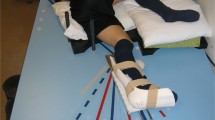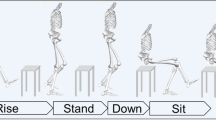Abstract
We investigated the factors which influence clinical subjective symptoms during activities in PCL deficient patients by evaluating knee laxity, muscle strength and knee mechanics during level walking, stair ascent and descent. Twenty-two subjects with isolated PCL deficient knees and 20 healthy volunteers were involved. The PCL deficient patients were divided into two subgroups based on previous history of experiencing giving-way during stair descent; a giving-way group (10 subjects) and a non giving-way group (12 subjects). Giving-way during activities of daily living is a key symptom in isolated PCL deficient patients. No statistically significant differences in the knee laxity, muscle strength and knee mechanics during level walking and were observed between the giving-way group and the non giving-way group. However, we found significant differences in the knee mechanics during stair ascent and descent between the two groups, and these differences were more remarkable during stair descent. Peak values of knee flexion angle, external knee flexion moment and posterior knee force during early stance phase were significantly lower in the giving-way group than in the non giving-way group. This study indicated that the symptom of giving-way during stair descent was related to knee mechanics during stair descent, unlike other quantitative evaluations such as KT-2000 or Biodex.



Similar content being viewed by others
References
Andriacchi TP, Anderson GB, Fermier RW, Stern D, Galante JO (1980) A study of lower-limb mechanics during stair-climbing. J Bone Joint Surg [Am] 62:749–757
Balkfors B (1982) The course of knee-ligament injuries. Acta Orthop Scand Suppl 198:1–99
Berchuck M, Andriacchi TP, Bach BR, Reider B (1990) Gait adaptations by patients who have a deficient anterior cruciate ligament. J Bone Joint Surg [Am] 72:871–877
Cross MJ, Powell JF (1984) Long-term follow up of posterior cruciate ligament rupture: a study of 116 cases. Am J Sports Med 12:292–297
Dandy DJ, Pusey RJ (1982) The long-term results of unrepaired tears of the posterior cruciate ligament. J Bone Joint Surg [Br] 64:92–95
Girgis FG, Marshall JL, Monajem A (1975) The cruciate ligaments of the knee joint. Anatomical, functional and experimental analysis. Clin Orthop 106:216–231
Hooper DM, Morrissey MC, Crookenden R, Ireland J, Beacon JP (1999) Gait adaptations in patients with chronic posterior instability of the knee. Clin Biomech 17:227–233
Keller PM, Shelborne D, McCarroll JR, Retting AC (1993) Non operatively treated isolated posterior cruciate ligament injuries. Am J Sports Med 21:132–136
LaPrade RF, Wentorf F (2002) Diagnosis and treatment of posterolateral knee injuries. Clin Orthop 402:110–121
Lysholm J, Gillquist J (1982) Evaluation of knee ligament surgery results with special emphasis on use of a scoring scale. Am J Sports Med 10:150–154
Matsumoto H, Otani T, Suda Y, Niki Y, Fujikawa K (2000) Posterior cruciate ligament injury and return to sports activities. Jpn J Orthop Sports Med 20:411–416
Matsumoto H, Fujikawa K, Takeda T, Toyoda T (1994) Assessment of knee instability using the KT-2000 knee arthrometer (in Japanese). Orthop Surg 45:759–766
Parolie JM, Bergfeld JA (1986) Long-term results of nonoperative treatment of isolated posterior cruciate ligament injuries in the athlete. Am J Sports Med 14:35–38
Patel RR, Hurwitz DE, Bush-Joseph CA, Bach BR, Andriacchi TP (2003) Comparison of clinical and dynamic knee function in patients with anterior cruciate ligament deficiency. Am J Sports Med 31:68–74
Satku K, Chew CN, Seow H (1984) Posterior cruciate ligament injuries. Acta Orthop Scand 55:26–29
Shelborne KD, Davis TJ, Patel DV (1999) The natural history of acute, isolated, nonoperatively treated posterior cruciate ligament injuries. Am J Sports Med 27(3):276–283
Torg JS, Barton TM, Pavlov H, Stine R (1989) Natural history of the posterior cruciate ligament-deficient knee. Clin Orthop 246:208–216
Acknowledgments
We would like to thank Tsuyoshi Takeda (Keio University) for providing outstanding patient support. We would also like to thank Satoshi Imai (Keio University) for assistance in measurements of muscle strength using BIODEX, and Chris O Dyrby and Ajit Chaudhari (Stanford University) for advice on this study.
Author information
Authors and Affiliations
Corresponding author
Rights and permissions
About this article
Cite this article
Iwata, S., Suda, Y., Nagura, T. et al. Clinical disability in posterior cruciate ligament deficient patients does not relate to knee laxity, but relates to dynamic knee function during stair descending. Knee Surg Sports Traumatol Arthrosc 15, 258–265 (2007). https://doi.org/10.1007/s00167-006-0183-x
Received:
Accepted:
Published:
Issue Date:
DOI: https://doi.org/10.1007/s00167-006-0183-x




